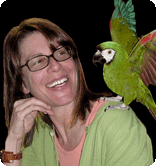Discouraging certain parrot behaviour

Hello Dr. Friedman, As of yesterday, Pyewacket, my rescued B&G;macaw, started climbing to the floor from his cage or tree, and walking around the living room. I’m babysitting two dogs right now (see my blog “Pyewacket goes to the dogs”) and it is possible that he just wants to be the dogs, but he hasn’t walked directly toward them. Of course this gives me great anxiety about the dogs and about whether I will have to parrot proof the whole house. Can you suggest a way to discourage this? Perhaps he will stop in 2 weeks when the dogs leave, but I’m worried. He hasn’t ever been closed in his cage and I hate to start.
Thanks Eva Sargent

Hello Eva, Asking this question is like lighting fireworks: It produces a shower of bright lights about behavior! You asked if there is a way to discourage your parrot from climbing to the floor and walking around the living room. Further, you hypothesized that his motivation may be being with the dogs you are pet sitting. I see that you have a good nose for behavior by how naturally you assessed the probable function of this behavior and the events that set it into play:
Antecedents (Predictor): Dogs in house
Behavior: Climbing to floor
Consequences (Purpose): Access to dogs
To know for sure if this functional assessment is correct, we would need to test it by varying the antecedents and consequences, and observing the resulting effect on the behavior. However, it sounds like a reasonable working hypothesis if Pyewacket has not gone to the floor before the arrival of the dogs and if he orients himself toward the dogs once he’s on the floor.
As you imply, behavior doesn’t spew out of parrots (any animal) willy-nilly and Pyewacket is not being “obstinate”, “stubborn” or “recalcitrant” or any other such vague label. Even positive labels like “curious” and “bold” don’t tell us what we need most to know: The behavior that Pyewacet *does* and the *conditions* under which he does it. Pyewacket behaves in this way given the particular conditions described in the antecedent because it serves a particular purpose described in the consequence (pending further info). That’s very informative.
You mentioned parrot-proofing the house and by that I’m guessing that you mean doing whatever it takes to prevent the dogs and parrot from having access to one another. That is certainly a reasonable approach to the problem. However, if you are looking for a learning solution, this is what you need to know: We have only antecedent changes and consequence changes with which to change behavior. That’s the short and the long of it! So, rather than giving you a recipe, here are some suggestions to consider as you develop your behavior intervention:
First, let’s change the orientation of your question: Instead of asking if we can get Pyewacket *not to do* something, let’s ask a more empowering question:“What do we want him *to do* instead? This way we identify a behavior target to increase, which puts us squarely in the positive reinforcement zone where we want to be (given the known postive relationship between rate of reinforcement and quality of life).
It’s tempting to choose a behavior target like *staying* on the cage or tree but we know that parrots, like all animals, are *built to behave*, not to be still. So, we need to identify an *active behavior* for our target. From there it becomes a relatively straight-forward matter of either 1) arranging the environment so that a behavior your parrot already does is even more reinforcing than going to the floor, and/or 2) teaching a new behavior that requires the cage or tree location and then following the plan in #1.
Now we’re thinking like behavior analysts!
Competing with the novelty reinforcer produced by investigating dogs won’t be easy but it can be done by arranging *highly reinforcing* activities on the cage and tree. That may take the form of favorite chewable and manipulable items and food treats presented in interesting and engaging ways and changing them frequently to add a high degree of novelty and variety, the reinforcing spice of life!
We can add to that the strategy by “draining” the strength of the reinforcement provided by going to the floor. This may be accomplished with a supervised introduction to the dogs, depending on the dogs’ behavior of course. But, this may be less practical with dogs who are only temporarily in your home as you may not have the time needed to build a safe relationship.
Increasing the behavior we want to see more is always a matter of making the right behavior easier than the wrong behavior and making the right behavior more reinforcing. How we accomplish that is only limited by your creativity.
Hope that helps you solve this and any future problems that may arise!
All best,
S

































